®
Personal Computer
OPERATING INSTRUCTIONS
CF-71 Series
Contents
Getting Started
Read Me First ................................................. 6
First-time Operation ........................................ 7
95
[Additional Manual]
Reference Manual
This manual can be accessed on your computer. Please
refer to page 18 on how to access the Reference Manual.
Contents
• Key Combinations
• LED Indicators
• Panasonic Hand Writing
• Port Replicator
• Using a Printer
• Using an External Display
• Using USB Devices
• Infrared Data
• Suspend/Hibernation
(Touch Pad)
Communications
• Hard Disk Drive
• Setup Utility
• Technical Information
• List of Error Codes
• DMI Viewer
• Dealing With Problems
Functions
• Security Measures
• Computing On the Road
• Battery Power
• Using a Multimedia
Pocket Device
• Using PC Cards
• Adding Memory
Operation
Starting Up/Shutting Down............................ 12
Usage, Carrying and Maintenance ............... 19
Troubleshooting
List of Error Codes ........................................ 20
Dealing With Problems .................................. 23
Reinstalling Software .................................... 25
Appendix
LIMITED USE LICENSE AGREEMENT ....... 26
Names and Functions of Parts ...................... 28
Specifications ................................................30
d
e
t
r
a
t
S
g
n
i
t
t
e
G
n
o
i
t
a
r
e
p
O
g
n
i
t
o
o
h
s
e
b
u
o
r
T
l
i
x
d
n
e
p
p
A
�
Customer's Record
Dealer's
Name
Dealer's
Address
Model
No.*
Serial
No.
or
Code
No.
Date
of
Purchase
*For the Model No., insert the 11 digit number (for example, CF-71GYAGBAM) located on the bottom of the computer.
Introduction
Thank you for purchasing the Panasonic computer. Please read the operating instructions thoroughly for proper operation of your
new computer.
Illustrations in this manual
NOTE:
CAUTION:
WARNING:
NOTE provides a useful fact or helpful information.
CAUTION indicates a condition that may result in minor or moderate injury.
WARNING indicates a hazard that may result in moderate or serious injury.
[Start] - [Shut Down]: This illustration means to click [Start], then to click [Shut Down].
(For some applications, you may need to double-click.)
Enter :
This illustration means to press the [Enter] key.
Fn + F5 :
This illustration means to press and hold the [Fn] key, then press the [F5] key.
:
Where to go for referred information.
: This illustration means to refer to the Reference Manual, which is available on your com-
puter. Please refer to page 18 on how to access this manual.
Copyright
This manual is copyrighted by Matsushita Electric Industrial Co., Ltd. with all rights reserved. No part of this manual may be
reproduced in any form without the prior written permission of Matsushita Electric Industrial Co., Ltd.
No patent liability is assumed with respect to the use of the information contained herein.
©Matsushita Electric Industrial Co., Ltd. 1999. All Rights Reserved.
Disclaimer
Computer specifications and manuals are subject to change without notice. Matsushita Electric Industrial Co., Ltd. assumes no
liability for damage incurred directly or indirectly from errors, omissions or discrepancies between the computer and the manuals.
Trademarks
PS/2™ is a trademark of International Business Machines Corporation.
Microsoft, MS-DOS, Windows and IntelliMouse are registered trademarks of Microsoft Corporation of the United States and/or
other countries.
Pentium is a registered trademark of Intel Corporation.
PhoenixCard Manager is a trademark of Phoenix Technologies Ltd.
Imation, the Imation Logo, the circle-pyramid logo, SuperDisk and SuperDisk logo are trademarks of Imation Corp.
Acrobat is a registered trademark of Adobe Systems Incorporated.
Panasonic is a registered trademark of Matsushita Electric Industrial Co., Ltd.
2
�
For U.S.A.
Federal Communications Commission Radio
Frequency Interference Statement
Note: This equipment has been tested and found to comply with
the limits for a Class B digital device, pursuant to Part 15 of the
FCC Rules. These limits are designed to provide reasonable
protection against harmful interference in a residential
installation. This equipment generates, uses and can radiate radio
frequency energy and, if not installed and used in accordance
with the instructions may cause harmful interference to radio
communications. However, there is no guarantee that interference
will not occur in a particular installation. If this equipment does
cause harmful interference to radio or television reception, which
can be determined by turning the equipment off and on, the user
is encouraged to try to correct the interference by one or more of
the following measures:
Reorient or relocate the receiving antenna.
Increase the separation between the equipment and receiver.
Connect the equipment into an outlet on a circuit different
from that to which the receiver is connected.
Consult the Panasonic Service Center or an experienced ra-
dio/TV technician for help.
Warning
To assure continued compliance, use only shielded interface
cables when connecting to a computer or peripheral. Also, any
changes or modifications not expressly approved by the party
responsible for compliance could void the user's authority to
operate this equipment.
This device complies with Part 15 of the FCC Rules. Operation
is subject to the following two conditions:
(1) This device may not cause harmful interference, and
(2) This device must accept any interference received, including
interference that may cause undesired operation.
Responsible Party: Matsushita Electric Corporation of America
One Panasonic Way
Secaucus, NJ 07094
Tel No:1-800-LAPTOP-5 (1-800-527-8675)
Lithium Battery
Lithium Battery!
This computer contains a lithium battery to enable the date,
time, and other data to be stored in it.
The battery should only be exchanged by service personnel.
Warning! Risk of explosion from incorrect installation or mis-
application!
Avertissement concernant la pile au lithium
(pile de sauvegarde)
Pile au lithium!
Le micro-ordinateur renferme une pile au lithium qui permet de
sauvegarder certaines données comme la date et l'heure
notamment. Elle ne devra être remplacée que par un technicien
qualifié.
Avertissement! Risque d'explosion en cas de non respect de cette
mise en garde!
Precautions
This computer has been designed so as to minimize shock to the
LCD and hard disk drive, the leakage of liquid (e.g., water) from
the keyboard, etc., but no warranty is provided against such
trouble. Therefore, as a precision instrument, please be extremely
careful in the handling.
Usage
Avoid Extreme Heat and Cold
Do not store or use the computer in locations
exposed to heat, direct sunlight, or extreme cold.
Avoid moving the computer between locations
with large temperature differences.
Operation: 5 oC to 35 oC (41 oF to 95 oF)
Storage:
-20 oC to 60 oC (-4 oF to 140 oF)
Avoid Direct Sunlight on the LCD Panel
The LCD panel should not be exposed to direct
sunlight or ultraviolet light.
Avoid Humidity, Liquids and Dust
Do not store or use the computer in locations
exposed to high humidity, liquids (including rain)
or dust.
Prevent Shock
Avoid subjecting the computer to severe
vibrations or impact. Do not place the computer
inside a car trunk.
Avoid Radio Frequency Interference
Do not place the computer near a television or
radio receiver.
Avoid more than casual contact with any heat produc-
ing area of the notebook computer, power adapter, and
any option or accessory you use with it.
Even low heat, if warmer than body temperature, can
cause a burn, if the skin is exposed to the heat source
for a long enough period of time.
Handling
Avoid Magnetic Fields
Keep the computer away from magnets.
Avoid Stacking
Do not place heavy objects on top of the
computer.
Keep Small Objects Away
Do not insert paper clips or other small objects
into the computer.
Do Not Disassemble the Computer
Do not attempt to disassemble your computer.
Avoid Excessive Force on the Display
Do not apply excessive downward force on the
display when it is completely opened, especially
when plugs and/or cables are connected to the
rear of the computer.
3
�
Precautions
Peripherals
Incorrectly using peripheral devices may lead to a decrease
in performance, an increase in temperature and/or damage
your computer. For more information on peripheral devices,
please refer to the Reference Manual.
CAUTION
The charging terminal of the
battery pack is used with the
battery charger, which is sold
separately.
Charging Terminal
Never connect anything to the charging terminal other than
the exclusive adapter that is supplied with the battery charger.
Doing so could damage the device connected to the battery
pack, the cable, and the battery pack itself. It could also
result in overheating or bursting.
Care should be exercised with regard to the following in
order to avoid the possibility of liquid leakage, overheat-
ing, or bursting.
Avoid Heat
Do not throw the battery pack into a fire or
expose it to excessive heat.
Keep Articles Away
Do not place the battery pack together with ar-
ticles such as necklaces or hairpins when carry-
ing or storing.
Do Not Disassemble
Do not insert sharp objects into the battery pack,
expose it to bumps or shocks, deform, disas-
semble, or modify it.
Do Not Short
Do not short the positive (+) and negative (-)
contacts.
Avoid Extreme Heat, Cold and Direct Sun-
light
Do not charge, use or leave the battery pack for
extended periods where it will be exposed to di-
rect sunlight, in a hot place (in an automobile on
a sunny day, for example), or in a cold place.
Do Not Use With Any Other Computer
The battery pack is rechargeable and was in-
tended for the specified computer or charger. Do
not use it with a computer other than the one for
which it was designed.
Do Not Put into a Microwave
Do not put the battery pack into a microwave
oven or a pressurized chamber.
Discontinue Use
Should the battery emit an abnormal odor, be-
come hot to the touch, become discolored,
change shape, or become in any way different
from normal, remove it from the computer or
charger and discontinue use.
Do not touch the terminals on the battery pack. The battery
pack may no longer function properly if the contacts are dirty
or damaged.
Do not expose the battery pack to water, or allow it to be-
come wet.
If the battery pack will not be used for a long period of time
(a month or more), charge or discharge (use) the battery pack
until the remaining battery level becomes 30% to 40% and
store it in a cool, dry place.
This computer prevents overcharging of the battery by re-
charging only when the remaining power is less than approx.
95% of capacity.
The battery pack is not charged when the computer is first
purchased. Be sure to charge it before using it for the first
time. When the AC adapter is connected to the computer,
charging begins automatically.
Should the battery leak and the fluid get into your eyes, do
not rub your eyes. Immediately flush your eyes with clear
water and see a doctor for medical treatment as soon as pos-
sible.
NOTE
The battery pack may become warm during recharging or
normal use. This is completely normal.
Recharging will not commence outside of the allowable
temperature range (0 °C to 45 °C (32°F to 113 °F))
"Battery Power". Once the allowable range re-
quirement is satisfied, charging begins automatically. Note
that the recharging time varies based on the usage condi-
tions. (Recharging takes longer than usual when the tem-
perature is 10 °C (48 °F) or less.)
If the temperature is low, the operating time is shortened. Only
use the computer within the allowable temperature range.
Although the battery has remaining capacity, the battery
indicator may light up red or emit a beep. This indicates a
significant rise in the temperature (60 °C (140 °F) or more)
of the battery pack
"Battery Power". This is
typically caused by the fact that the battery pack has been
delivering a high level of power because the computer has
been used with the display at the brightest setting and with
the power-saving function off.
To protect the battery pack from increases in temperature,
the brightness of the display automatically decreases, al-
lowing the temperature of the battery to drop. In this con-
dition, if the computer is left as is, it will automatically go
off after about three minutes have elapsed. Within that
period, therefore, be sure to connect the AC adapter or
shut the computer OFF after saving any open data (if nec-
essary).
4
�
CAUTION!
THIS PRODUCT UTILIZES A LASER.
USE OF CONTROLS OR ADJUSTMENTS OR PERFORMANCE OF PROCEDURES OTHER THAN THOSE SPECIFIED
HEREIN MAY RESULT IN HAZARDOUS RADIATION EXPOSURE.
DO NOT OPEN COVERS AND DO NOT REPAIR YOURSELF.
REFER SERVICING TO QUALIFIED PERSONNEL
AVERTISSEMENT!
CET APPAREIL UTILISE UN LASER.
L'UTILISATION DE COMMANDES OU DE RÉGLAGES OU L'EXÉCUTION DE PROCÉDURES AUTRES QUE CELLES
SPÉCIFIÉES ICI PEUVENT PROVOQUER UNE EXPOSITION À DES RADIATIONS DANGEREUSES.
NE PAS OUVRIR LES COUVERCLES NI ESSAYER DE RÉPARER SOI-MÊME.
CONFIER TOUT TRAVAIL D'ENTRETIEN À UN PERSONNEL QUALIFIÉ.
WARNUNG!
DIESES PROUKT ERZEUGT LASERSTAHLUNG.
DURCHFÜHRUNG ANDERER VORGÄNGE ALS DER HIER ANGEGEBENEN KANN ZU GEFÄHRLICHER STRAHLUNG
FÜHREN.
REPARATUREN DÜRFEN NUR VON QUALIFIZIERTEM FACHPERSONAL DURCHGEFÜHRT WERDEN.
VARNING
Om apparaten används på annat sätt än i denna bruksanvisnig specificerats, kan användaren utsättas för osynlig laserstrålning, som
överskrider gränsen for laserklass 1.
CLASS 1 LASER PRODUCT
LASER KLASSE1
5
�
Read Me First
Saving Data on the Hard Disk
Do not expose your computer to shock.
Please use care when handling your computer, shock may damage your hard disk or make
your software applications and data unusable.
Do not power off your computer while software applications are running or HDD indi-
cator (
Properly shut Windows* down to avoid problems ([Start] - [Shut Down] ).
Save all valuable data to floppy disks.
Backing up data to floppy disks will limit damage should trouble occur to your computer or
should you inadvertently change or erase data.
Use the security function for all important data. (
"Security Measures")
) is on.
Saving Data on Floppy Disks
* This computer uses Microsoft® Windows® 95 Operating System.
) is on.
Do not power off your computer or press the floppy disk drive eject button while the
MP indicator (
Doing so may damage the data on the floppy disk and render the disk useless.
Use care when handling floppy disks.
To protect the data on your floppy disks or to prevent a floppy disk from becoming stuck in
your computer, avoid the following:
• Sliding the shutter on the floppy disk manually.
• Exposing the disk to a magnetic field.
• Storing the disk in locations prone to high temperatures, low pitched noise, dampness, or dust.
• Applying more than one label on the disk.
Confirm the contents of a floppy disk before formatting it.
Confirm that no important data is on the disk, because all data on the disk will be erased.
Use the write-protect tab.
This is a must for preserving im-
portant data. This prevents your
data from being erased or overwrit-
ten.
Write-protect Tab
Write Disable
Write Enable
Computer Viruses
Users are advised to purchase the latest versions of virus protection software and use
them regularly.
We recommend you run the software:
• When booting your computer.
• After receiving data.
We recommend that you check data received on floppy disks or from external sources, such
as data downloaded from the Internet, e-mail, etc. (For compressed files, please uncompress
them before running a check).
d
e
t
r
a
t
S
g
n
i
t
t
e
G
6
�
First-time Operation
Please read the steps below to help you learn what parts are included, and to gain an understand-
ing of some basic computer-related operations.
1Confirm the inclusion of all parts
Make sure the parts shown in the figure have been supplied. If any of these items are
missing or is not working properly, please contact Panasonic Technical Support.
CAUTION
Have 2HD floppy disks prepared to create disks that will allow you to reinstall
the operating system should a problem occur. Be sure that these disks are not
write-protected. (It is not necessary for these disks to be preformatted.)
AC Adapter ............................ 1
AC Cord ................................. 1
d
e
t
r
a
t
S
g
n
i
t
t
e
G
CF-AA1639
Battery Pack .......................... 1
CD-ROM Pack........................ 1
CF-VZSU09
CF-VCD711
Operating Instructions ......... 1
Windows 95 System Pack .... 1
Windows® 95 Book
Registration Card
Product Recovery CD-ROM
Using a CD-ROM pack
"Using a Multimedia Pocket Device"
1
2Connect the battery pack
1
Slide the latch located at the front and lift open the display.
Latch
7
�
First-time Operation
Cover
3
2
Open Slot
2 Insert a thin, flat object, like a ruler into the open slot on the left side of the com-
puter.
3
Open the cover.
4 Pull the tab outside the frame of the computer, and insert the non-connector-side of
the battery pack into the computer with the label- side up.
Connector
5
5
Insert the connector-side of the battery pack into the computer to secure the connec-
tor.
4
Tab
Label-side up
Flat Cable
6
Tab
Press down on these areas firmly.
CAUTION
Be sure the battery pack is properly connected to the connector.
If the tab is set under the battery pack, the battery pack will be difficult to
remove later.
Do not touch the battery connector on the computer and flat cable. The com-
puter may not operate properly.
6
Close the cover until it clicks into place; be sure the tab does not get caught when
closing the cover.
CAUTION
When closing the cover;
Be careful not to get your fingers
caught in the cover.
There are instances the right side
of the cover will float. In such
cases, attempt to close the cover
again by pushing the projection.
Projection
2
1
3
3Connect your computer to a power outlet
CAUTION
Be sure the AC adapter is connected until completing Step 8 on page 10.
Handling the AC adapter
Do not twist or pull the AC power cord forcefully. Doing so may damage the
connections.
Use only the specified AC adapter with your computer. Using an AC adapter
other than the one supplied might damage the battery and/or the computer.
When the DC plug is not connected to the computer, disconnect the AC cord
from your AC wall outlet.
Problems such as sudden voltage drops/surges may arise during periods of thun-
der and lightning. Since this could adversely affect your computer, an
uninterruptible power source (UPS) is highly recommended unless the battery
pack is installed.
d
e
t
r
a
t
S
g
n
i
t
t
e
G
8
�
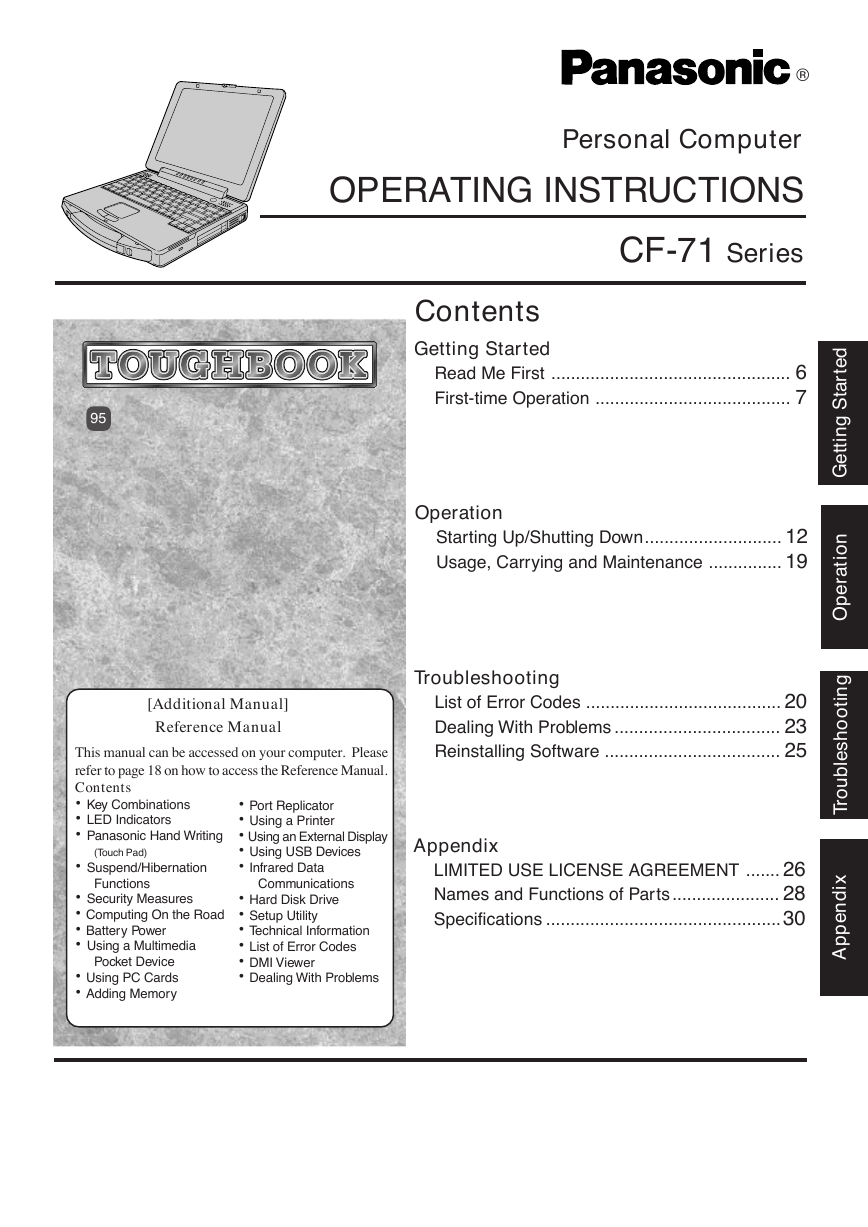
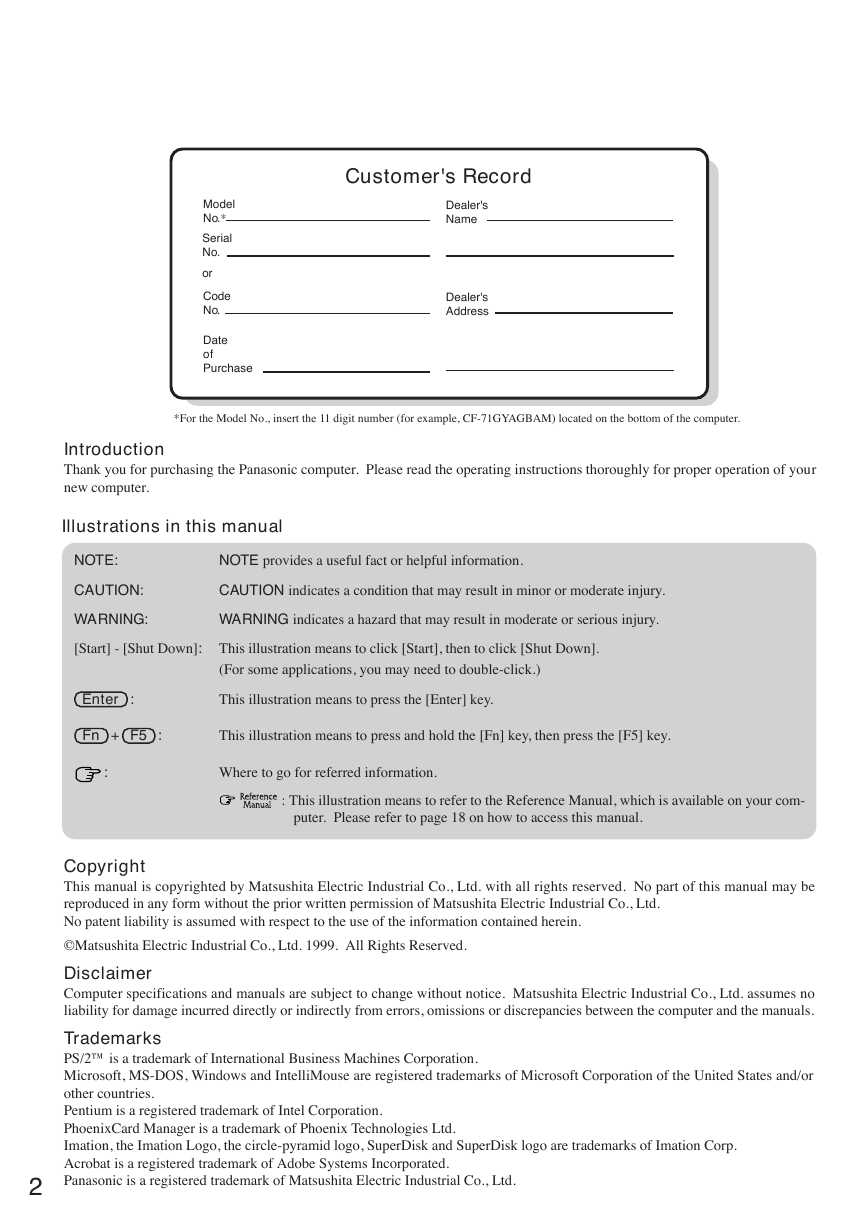

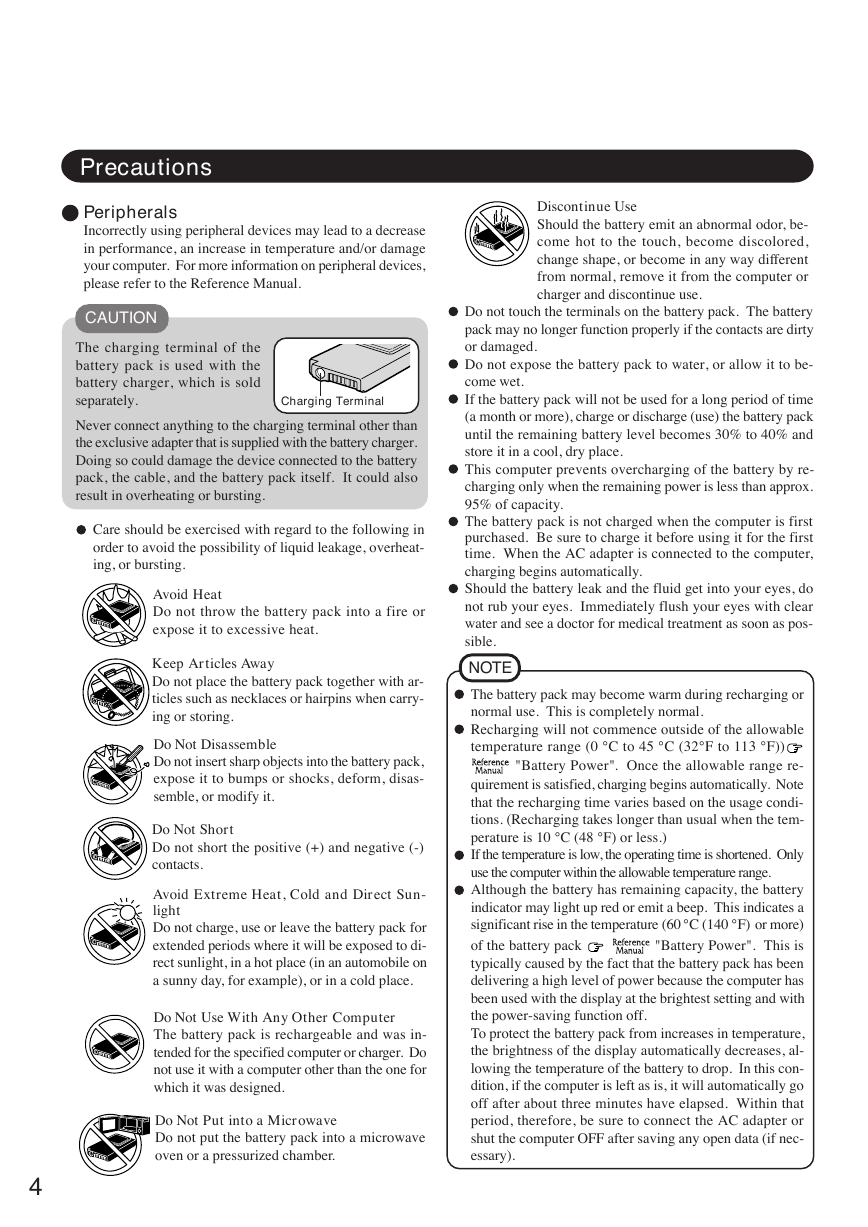
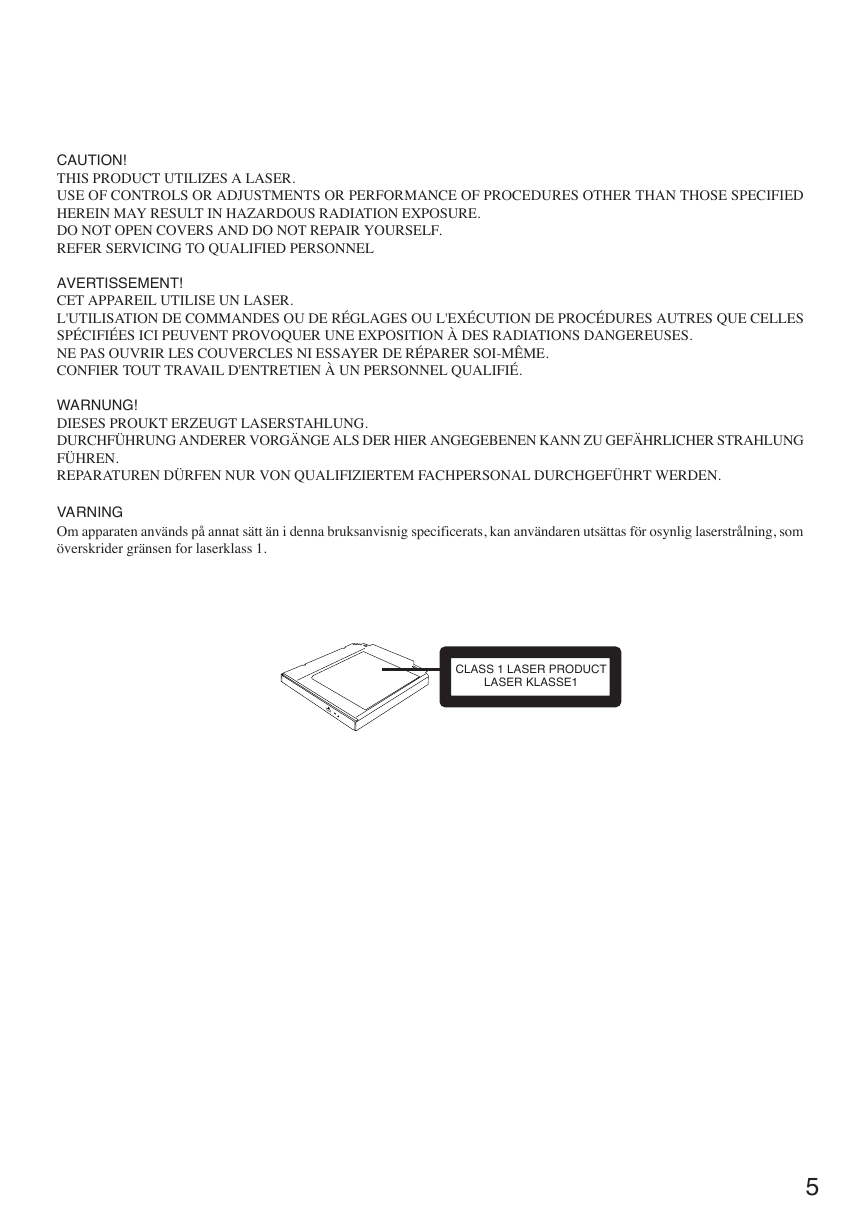
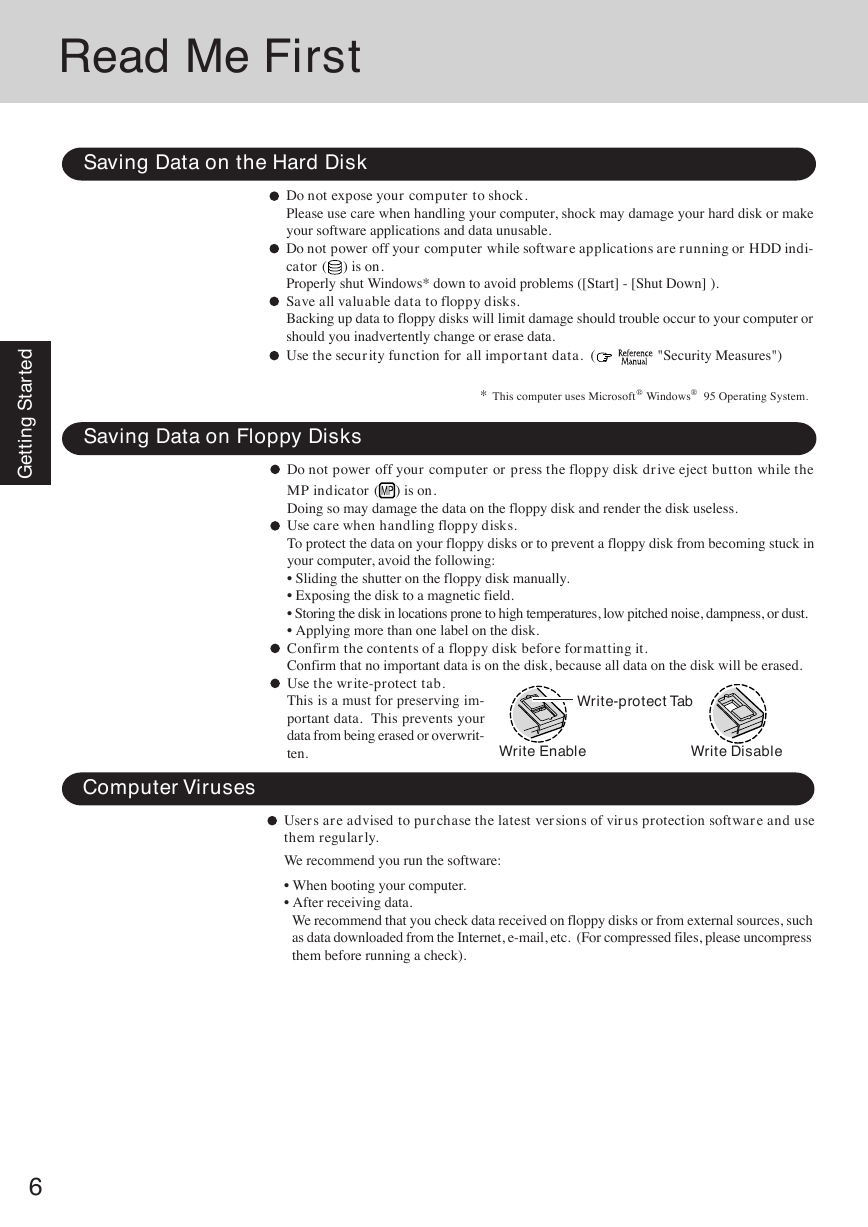
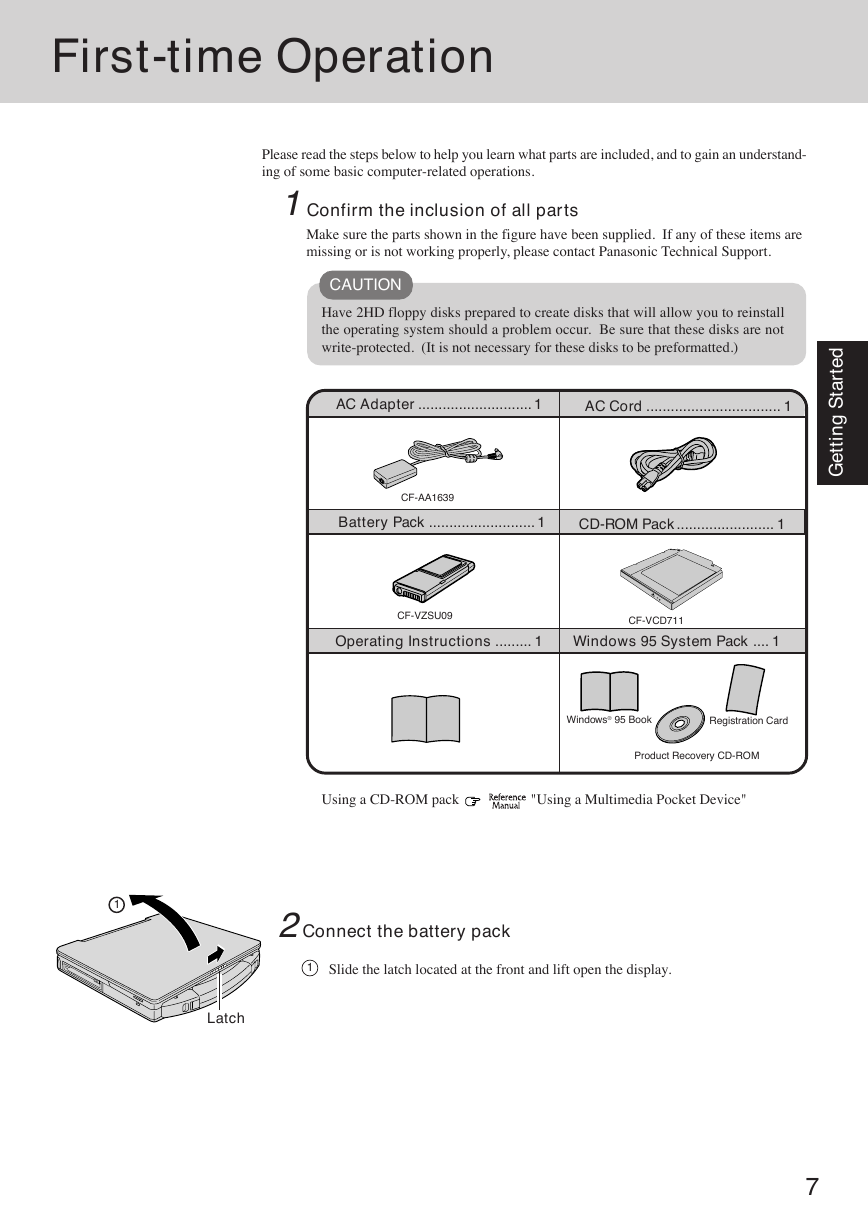
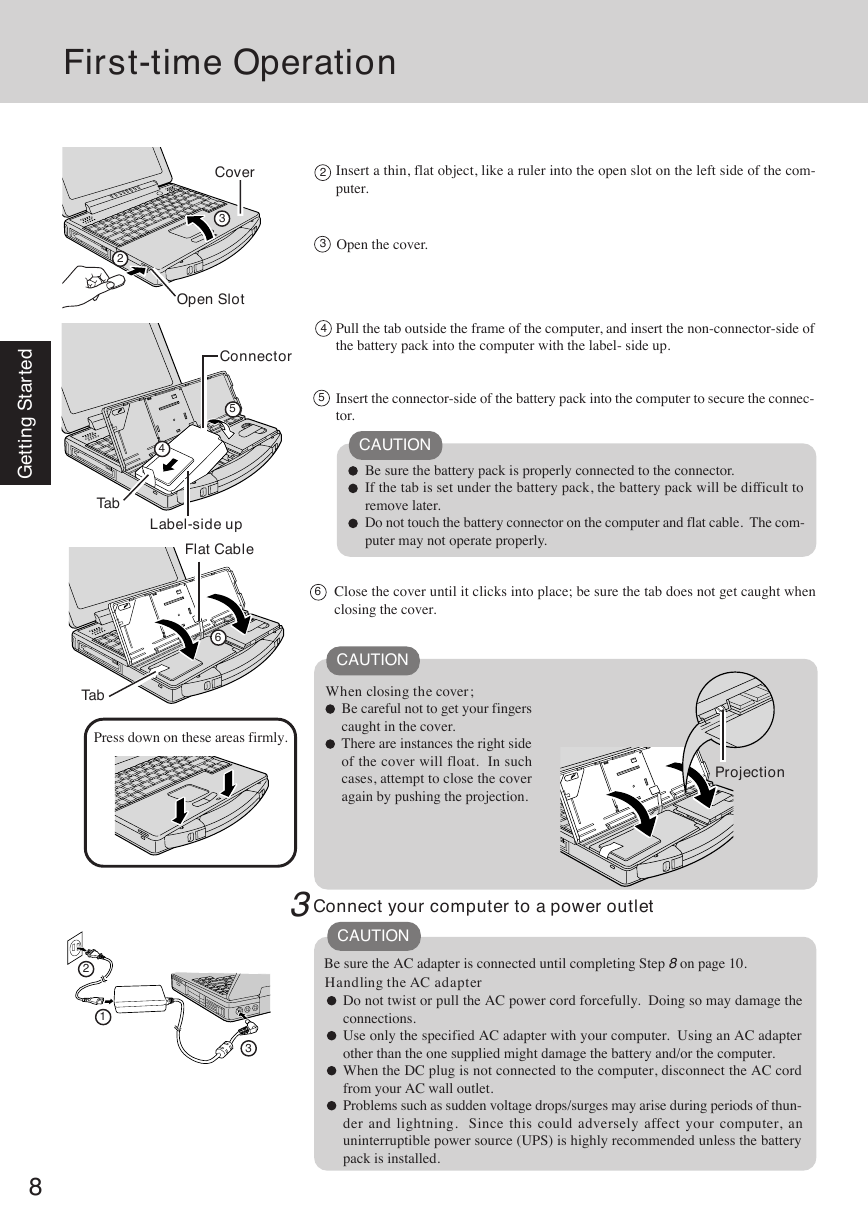








 2023年江西萍乡中考道德与法治真题及答案.doc
2023年江西萍乡中考道德与法治真题及答案.doc 2012年重庆南川中考生物真题及答案.doc
2012年重庆南川中考生物真题及答案.doc 2013年江西师范大学地理学综合及文艺理论基础考研真题.doc
2013年江西师范大学地理学综合及文艺理论基础考研真题.doc 2020年四川甘孜小升初语文真题及答案I卷.doc
2020年四川甘孜小升初语文真题及答案I卷.doc 2020年注册岩土工程师专业基础考试真题及答案.doc
2020年注册岩土工程师专业基础考试真题及答案.doc 2023-2024学年福建省厦门市九年级上学期数学月考试题及答案.doc
2023-2024学年福建省厦门市九年级上学期数学月考试题及答案.doc 2021-2022学年辽宁省沈阳市大东区九年级上学期语文期末试题及答案.doc
2021-2022学年辽宁省沈阳市大东区九年级上学期语文期末试题及答案.doc 2022-2023学年北京东城区初三第一学期物理期末试卷及答案.doc
2022-2023学年北京东城区初三第一学期物理期末试卷及答案.doc 2018上半年江西教师资格初中地理学科知识与教学能力真题及答案.doc
2018上半年江西教师资格初中地理学科知识与教学能力真题及答案.doc 2012年河北国家公务员申论考试真题及答案-省级.doc
2012年河北国家公务员申论考试真题及答案-省级.doc 2020-2021学年江苏省扬州市江都区邵樊片九年级上学期数学第一次质量检测试题及答案.doc
2020-2021学年江苏省扬州市江都区邵樊片九年级上学期数学第一次质量检测试题及答案.doc 2022下半年黑龙江教师资格证中学综合素质真题及答案.doc
2022下半年黑龙江教师资格证中学综合素质真题及答案.doc